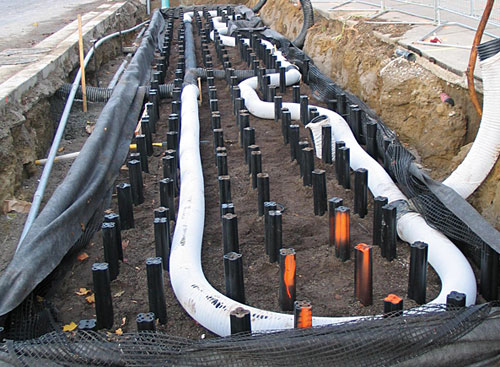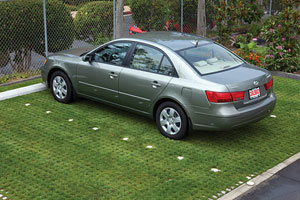Greening the Site: Design Options for Sustainability
A geo-grid material wraps the modular units once placed, overlapping on the sides and on the top layer. Utilities and irrigation lines can be accommodated through openings in the units. Soil is placed in 8-inch lifts, lightly compacted by someone walking between the units. Depending on the soil conditions and potential need for stormwater retention, units can be stacked one, two or three layers deep, most commonly two layers. The units are topped with platforms that are snapped into place with rubber mallets, and the entire top of the system is covered with a geotextile fabric to separate the soil from the pavement section. Some manufacturers will provide on-site assistance to the contractor, and coordinate directly with the landscape architect.
Along Queensway in Toronto, Ontario, Canada, a stormwater retention "Proof of Concept" project was installed in 2008 in conjunction with Toronto Water and Ryerson University, to measure the benefits to water quality and retention over a 10- to 20-year period. For the City of Toronto, the system was designed to manage their typical rain event, approximately a 2-inch/24-hour storm. Perforated PVC pipe will distribute the stormwater thoroughly and evenly, and two trees were planted to test additional water and pollutant uptake. The city and university will monitor the water quality; the water utility will monitor the system's ability to manage stormwater.
 |
Stormwater proof of concept installation in Toronto Photo: Deep Root Partners, L.P. |
Green Walls at Studio 5c in Tempe, AZ |
One manufacturer has joined with a nationally known nursery to offer a plant list by geographic region that assists professionals in selection of hardy and appropriate regional plant materials for growing on vertical walls. Vines have been shown to climb up to 50 feet high and travel 10 to 12 feet horizontally. At Studio 5c in Tempe, Arizona, a deciduous vine has climbed over 40 feet to shade the west-facing façade and walkway from the desert sun as it releafs and blooms every summer, tempering the heat gain inside the building and shading access to each office suite. |
 |
Vines provide essential shade to Studio 5c in Tempe, Arizona. Photo: greenscreen® |
This approach is being tested in the Sustainable Sites Initiative (SITESâ„¢) by Casey Trees, a non profit organization restoring, enhancing and protecting the tree canopy of the Nation's Capital. The organization has embarked on an effort to test several types of green infrastructure, including rain gardens and suspended pavement. As a pilot project, their Washington, D.C. Brookland Headquarters building site design "uses trees to maximize canopy cover and manage stormwater."
Trees have been described as the lungs of a city, helping to improve air quality. Trees also work in conjunction with soils to reduce and slow stormwater runoff. In the 19th century, Frederick Law Olmsted, as Commissioner of Health for New York City, and the father of landscape architecture, recognized that trees were essential to human health and well-being. American Forests believes that "When trees are large and healthy, the ecological systems-soil, air and water-that support them are also healthy... The greater the tree cover and the less the amount of impervious surface, the more ecosystem services are produced in terms of reducing stormwater runoff, increasing air and water quality, storing and sequestering atmospheric carbon and reducing energy consumption due to direct shading of residential (and commercial and public) buildings."
No Room for Trees
But what if you don't have room for trees? What if your site needs a 20-foot-wide fire lane and space is severely limited? Is there a way to shade the west-facing glass on a building from late afternoon solar gain in the summer? Design approaches can add biomass to sites where there is no room for trees such as permeable but plantable pavements, and vertical plant screens or "green" walls. One approach contributes to reducing stormwater runoff, and the other can cool buildings and people.
A Stormwater and Permeable Pavement Option
 |
An example of plantable pavement at work Photo: SOIL RETENTION |
To add more biomass, permeable yet drivable surfaces within landscape areas may be an appropriate response. Allowing access for fire trucks and service vehicles through the landscape while maintaining permeability for parking lots and other impervious surfaces such as driveways adds back landscape area where there would otherwise be vehicular circulation, often increasing runoff and deteriorating water quality.
Nick Jansson, PE, LEED AP, Vice President, SOIL RETENTION, believes that "due to increased government regulations and general education/awareness, consumers and design professionals are looking for simple solutions to stormwater pollution, including paving products that can bio-filter, infiltrate, and store run-off-while not losing valuable site area."
Some municipalities and water districts concerned with stormwater quality and quantity generated by new developments have even begun to require fees for treating polluted stormwater runoff or increased runoff volumes. Using a permeable pavement is one approach to reducing stormwater volumes and allowing water to reach soils and plants that can filter the runoff. Another approach might be to add landscape that can take the load of a fire truck, a (hopefully) incidental use, and loads of other vehicles such as delivery trucks and automobiles.









